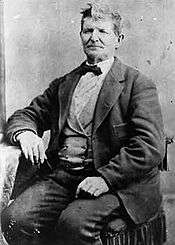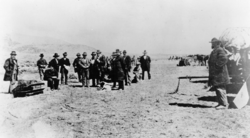John D. Lee
| John D. Lee | |
|---|---|
 | |
| Member of the Council of Fifty[1] | |
| 1844 – March 23, 1877 | |
| Called by | Brigham Young 14 March and 11 April 1844. |
| End reason | Released due to age[1] |
| Utah Territorial Legislature | |
| In office | |
| 1858 | |
| Political party | unknown |
| Personal details | |
| Born |
John Doyle Lee September 12, 1812 Illinois Territory, United States |
| Died |
March 23, 1877 (aged 64) Mountain Meadows, Utah Territory, United States |
| Resting place |
Panguitch City Cemetery 37°48′57.96″N 112°24′56.88″W / 37.8161000°N 112.4158000°W |
| Spouse(s) |
Agatha Ann Woolsey Nancy Bean Louisa Free Sarah Caroline Williams Rachel Andora Woolsey Polly Ann Workman Martha Elizabeth Berry Delethia Morris Nancy Ann Vance Emoline Vaughn Woolsey Nancy Gibbons Mary Vance Young Lavina Young Mary Leah Groves Mary Ann Williams Emma Louise Batchelor Terressa Morse Ann Gordge |
| Children | 56 |
John Doyle Lee (September 6, 1812 – March 23, 1877) was an American pioneer and prominent early member of the Latter Day Saint Movement in Utah. Lee was later convicted as a mass murderer for his complicity in the Mountain Meadows massacre, sentenced to death and was executed in 1877.
Early Mormon leader
John Doyle Lee was born on September 6, 1812, in Kaskaskia, Illinois Territory, and joined the Church of Jesus Christ of Latter Day Saints in 1838. He was a friend of Joseph Smith, founder of the Latter Day Saint Movement, and was the adopted son of Brigham Young under the early Latter Day Saint Law of Adoption doctrine. In 1839, Lee served a missionary with his boyhood friend, Levi Stewart, who together preached in Illinois, Ohio, Kentucky, and Tennessee. During this period Lee converted and baptized "Wild Bill" Hickman. Lee practiced plural marriage and had nineteen wives (at least eleven of whom eventually left him) along with sixty-seven children.
Lee was allegedly a member of the Danites, a vigilante paramilitary group, although this claim has been disputed. Lee was also an official scribe for the Council of 50, a group of men who in the days of Joseph Smith Jr. and Brigham Young, worked together to provide guidance in practical matters to the church, specifically concerning the move westward out of the established areas United States of America in the east to the Rocky Mountains. After Smith's death, Lee went with Brigham Young and church to what is now Utah, and worked towards establishing several new communities there. Some of those communities included Lee's Ferry and Lonely Dell Ranch, located near Page, Arizona. A successful and resourceful farmer and rancher, in 1856, Lee became a United States Indian Agent in the Iron County, Utah area, where he was assigned to help Native Americans establish farms.[2][3] In 1858, Lee served a term as a member of the Utah Territorial Legislature, and following church orders in 1872, Lee moved from Iron County and established a heavily used ferry crossing on the Colorado River, where the site is still called Lee's Ferry. The nearby ranch was named the Lonely Dell Ranch and is now listed on the National Register of Historic Places, together with the ferry site.
Mountain Meadows massacre

Massacre
In September 1857, the Baker-Fancher party, an emigrant group from Arkansas, camped at Mountain Meadows, a staging area in southern Utah used to prepare for the long crossing of the Mojave Desert by groups travelling westward to California.[4] They were attacked by a combined group of Native Americans and Mormon militiamen dressed as Native Americans. On the third day of the siege, Lee (not dressed as a Native American) approached the Baker-Fancher encirclement under cover of a white flag and convinced the emigrants to surrender their weapons and property to the Mormons in return for safe conduct to nearby Cedar City. The emigrants accepted the offer and surrendered, however approximately 120 of the Baker-Fancher party were then killed by Mormon militia and Paiute Indians, leaving only about 17 small children as survivors.[5][6] William Ashworth notes in his autobiography that after the massacre, the "leaders among the white men had bound themselves under the most binding oaths to never reveal their part in it." Lee told Brigham Young that the Indians had been solely responsible, that "no white men were mixed up in it."[7] Lee later maintained that he had acted under orders from his militia leaders, under protest, and remained active in Mormonism and local government for several years afterwards.
Arrest and execution
In 1874, Lee was arrested and tried for leading the massacre. The first trial ended inconclusively with a hung jury, seemingly because of the prosecution's attempt to portray Brigham Young as the true mastermind of the massacre. A second trial in 1877, in which the prosecution placed the blame squarely on Lee's shoulders, ended with his conviction and he was sentenced to death.[8] Lee never denied his own complicity, but claimed he had not personally killed anyone. He said he had been a vocally reluctant participant and later a scapegoat meant to draw attention away from other Mormon leaders who were also involved. Lee further maintained that Brigham Young had no knowledge of the event until after it happened. However, in the Life and Confessions of John D. Lee he (or an editor) wrote, "I have always believed, since that day, that General George A. Smith was then visiting southern Utah to prepare the people for the work of exterminating Captain Fancher's train of emigrants, and I now believe that he was sent for that purpose by the direct command of Brigham Young."[9]

On March 23, 1877, Lee was executed by firing squad at Mountain Meadows on the site of the 1857 massacre. His last words included a reference to Young: "I do not believe everything that is now being taught and practiced by Brigham Young. I do not care who hears it. It is my last word... I have been sacrificed in a cowardly, dastardly manner."[10] On April 20, 1961, the LDS Church posthumously reinstated Lee's membership in the church.[11]
Descendants
Lee had 19 wives and 56 children, and his descendants are now numerous. Former Solicitor General Rex E. Lee is a direct descendant of John Lee, as are his sons Senator Mike Lee of Utah and Utah Supreme Court Justice Thomas R. Lee.[12][13] Another descendant, Gordon H. Smith, was a U.S. Senator from Oregon.[14]:812 US Representatives Morris K "Mo" Udall (D-AZ) and Stewart Udall (D-AZ) and their sons, Mark Udall (D-CO) and Senator Tom Udall (D-NM) are also descendants.[14]:804; 806–807 Stewart Udall served as Secretary of the Interior under Presidents Kennedy and Johnson. See also the Lee-Hamblin family for a list of more of his noteworthy descendants.
Film portrayals
John Lee was portrayed by Jon Gries in the film September Dawn (2007).
Notes
- 1 2 Quinn, D. Michael (1980). "The Council of Fifty and Its Members, 1844 to 1945" (.pdf). BYU Studies. Provo, UT: Brigham Young University: 22–26. Retrieved October 4, 2011. External link in
|journal=(help) - ↑ Haymond, Jay M. (1994), "Lee, John D.", in Powell, Allan Kent, Utah History Encyclopedia, Salt Lake City, Utah: University of Utah Press, ISBN 0874804256, OCLC 30473917,
In January 1856 Lee was appointed U.S. government Indian Agent in the Iron County environs. His job was to distribute tools, seed, and supplies, and to assist the Indians with farming methods.
- ↑ "[Lee] became the local bishop and the Indian agent to the nearby Paiute Indians." PBS.org, John Doyle Lee (1812–1877)
- ↑ Parker, B.G. (1901), Recollections of the Mountain Meadow Massacre, Plano, CA Digital reprint (pdf) by the Mountain Meadows Massacre organization
- ↑ Denton, Sally (2003), American Massacre, New York: Random House, p. xxi
- ↑ Walker; Turley, Jr.; Leonard;, Ronald W.; Richard E.; Glen M. (2008). Massacre at Mountain Meadows. New York, NY: Oxford University Press. ISBN 978-0-19-516034-5.
- ↑ Ashworth 1934, p. 37
- ↑ "The West - The Last Words of John D. Lee". PBS.
- ↑ Lee 1877, p. 225
- ↑ PBS.org, The Last Words of John D. Lee
- ↑ Haymond, Jay M. (1994), "Lee, John D.", in Powell, Allan Kent, Utah History Encyclopedia, Salt Lake City, Utah: University of Utah Press, ISBN 0874804256, OCLC 30473917
- ↑ Esplin, Ronald K.; Turley, Richard E., Jr. (1992), "Mountain Meadows Massacre", in Ludlow, Daniel H, Encyclopedia of Mormonism, New York: Macmillan Publishing, pp. 966–968, ISBN 0-02-879602-0, OCLC 24502140
- ↑ "Mountain Meadows event remembered: Descendants join together in 'spirit of reconciliation'", Church News, September 22, 1990
- 1 2 Manderscheid, Lorraine (1996). Some Descendants of JOHN DOYLE LEE. Bellevue, Washington: Family Research and Development.
References
- Ashworth, William B. (1934), Autobiography of William B. Ashworth 1845–1934, Family History Collection, Brigham Young University.
- Brooks, Juanita (1992) [1961], John Doyle Lee: Zealot, Pioneer Builder, Scapegoat, Utah State University Press (paperback, 404pp), ISBN 0-87421-162-X.
- Cleland, Robert Glass; Brooks, Juanita, eds. (1955), A Mormon Chronicle: The Diaries of John D. Lee, 1848–1876, 2 volumes, San Marino, California: Huntington Library. Reissued in single-volume paperback: Huntington Library, June 2004: ISBN 0-87328-178-0
- Kelly, Charles, ed. Journals of John D. Lee, 1846–47 and 1859. Salt Lake City, Priv. print. for R. B. Watt by Western printing company, 1938. Republished: Salt Lake City: University of Utah Press, 1984.
- Lee, John D. (1877), Bishop, W.W., ed., Mormonism Unveiled; Or The Life and Confessions of the Late Mormon Bishop, John D. Lee; (Written by Himself), St. Louis: Bryan, Brand & Company.
External links
| Wikimedia Commons has media related to John D. Lee. |
- John D. Lee Family Association Official Website: http://www.johndleefamily.org
- Online tree of Lee Descendants: http://www.wadhome.org/lee
- http://www.pbs.org/weta/thewest/people/i_r/lee.htm Excellent sketch of Lee's life
- Works by John Doyle Lee at Project Gutenberg
- Works by or about John D. Lee at Internet Archive
- John D. Lee at Find a Grave
- John Doyle Lee's diary from at L. Tom Perry Special Collections, Brigham Young University